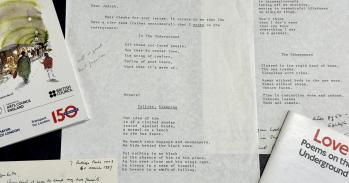
Research into more than 30,000 unpublished drafts and letters casts new light on the inspirational Austrian novelist and playwright.
Research into more than 30,000 unpublished drafts and letters casts new light on the inspirational Austrian novelist and playwright.
Intensity is everything
Arthur Schnitzler
The work of Arthur Schnitzler (1862–1931) has inspired playwrights and filmmakers, among them Stanley Kubrick, David Hare and Tom Stoppard, and was admired by contemporaries such as Sigmund Freud and Thomas Mann. Now, more than 75 years after his death, thousands of letters by the Austrian playwright are being analysed by a researcher in the Department of German.
PhD student Lorenzo Bellettini has embarked on a project to study part of a vast, as yet largely unpublished, archive of Schnitzler’s work. More than 30,000 pages, left behind by the Jewish writer after his death in 1931, were rescued from the Nazi book-burnings and brought to England by a Cambridge graduate, Eric Blackall, when Germany annexed Austria in 1938.
The archive – which includes Schnitzler’s only surviving letter to Sigmund Freud and his correspondence with the founder of Zionism, Theodor Herzl, and offers invaluable information on his relationship with some of the leading writers and artists of his time, from Thomas Mann and Henrik Ibsen to Hugo von Hofmannsthal, Richard Strauss and Gustav Mahler – has been available to researchers ever since, but most of it has remained unread. In the meantime, Schnitzler himself has attained almost cult status thanks partly to the way he was revered by later generations of writers for both stage and screen. His works have inspired Tom Stoppard’s Dalliance and Undiscovered Country, David Hare’s The Blue Room and Stanley Kubrick’s final film Eyes Wide Shut.
Sigmund Freud wrote in an admiring letter to the author: ‘I have gained the impression that you have learned through intuition – though actually as a result of sensitive introspection – everything that I have had to unearth by laborious work on other persons.’ However, our understanding of Schnitzler himself remains distorted, due both to numerous clichés surrounding him and to our lack of knowledge on the role that some of his closest friends had in his creative process. Through researching Schnitzler’s legacy, Lorenzo Bellettini aims to lift the ‘translucent screen’ that masks the man.
One important revelation emerging from this work sheds light on Schnitzler’s debt towards his close friend and fellow-writer Gustav Schwarzkopf. Letters between the two show that Schwarzkopf suggested significant changes to several of Schnitzler’s plays, some of which seem to have been incorporated verbatim, especially in the final scene of Intermezzo (which contains the play’s entire moral message).
As this illustrates, a study of Schnitzler’s papers inevitably goes beyond Schnitzler himself and sheds light on the world of writers around him. It is likely that comparably important revelations will be yielded from a study of Schwarzkopf’s intense correspondence with another great writer and friend, Hugo von Hofmannsthal. These two correspondences de facto pave the way for a re-evaluation of Schwarzkopf as a key figure in the group of fin-de-siècle writers known as Young Vienna who met in the 1890s and produced some of the greatest masterpieces of Austrian and European literature.
Lorenzo Bellettini’s research also makes use of diaries and letters to offer a fairer interpretation of some aspects of Schnitzler’s life that have often become clichés. Schnitzler’s sexuality is a case in point. The sexual themes in his work, often mirrored by his active social life, caused controversy in his own lifetime and have often dominated his reputation. Their interpretation is dangerous because in many ways it risks becoming an extension of the anti-Semitic propaganda that the Nazis devised to portray him as a lascivious Jew.
Perhaps as a consequence of this risk some researchers have been inclined to sweep Schnitzler’s sexuality under the carpet to purge his image and adapt it to chaste ideals. This is, of course, also wrong, because Schnitzler’s sexual life is well documented in his diaries. Between 1887 and 1892 he kept a written record of his exploits, with the sum total for every year, ranging from 208 in 1887 to over 400 in 1892. A correct interpretation of this bizarre habit becomes possible only if we see it in a larger context: Schnitzler’s erotic activity being an expression of that same energy and thirst for life and culture that accounts for his extraordinary productivity. It is the same enthusiastic élan we find in his diary entries recording the mind-boggling number of his visits to the theatre, opera and concerts, as well as his extensive readings.
As a teenager in the 1870s, for example, Schnitzler was, often unbeknownst to his father (who later forced him to pursue a medical career), writing complete novels in secret – including one that exceeds 600 pages in length. At 18, Schnitzler looked back proudly at the thousands of pages of the 23 complete and 13 unfinished plays he had already written.
This same energy is evident in the cultural voracity that characterised all his life and is recorded faithfully in his diaries and letters. He profited from the cultural cornucopia that Vienna, the capital of the Austro-Hungarian empire, had to offer, and this energy is also a constant of his travels. When he was in London in May–July 1888, the 26-year-old Schnitzler immersed himself in the capital’s culture with opera, theatre, balls, concerts and soireés in society. He filled his days with recitals at the once-magnificent St James Hall and Crystal Palace and with quintessentially English operettas, such as Gilbert and Sullivan’s Pirates of Penzance at the Savoy Theatre.
Schnitzler experienced life and culture with admirable intensity – his is the motto ‘Intensivsein ist alles’ (intensity is everything) – but not, however, without criticising what he saw. When, during a two-month stint in Paris in April–May 1897, he wrote to his friend Gustav Schwarzkopf about the ‘Haupterfolge der Saison’ (the hits of the season) at the local theatres, he enjoyed tearing most of them apart, with a splendid mixture of lightness, irony and vitriolic sarcasm.
Research into his ‘hidden manuscripts’ at Cambridge aims to shed light on this Schnitzler, the critical, lively, voracious, productive Schnitzler, the great ‘sceptical enamoured of life’ as the Austrian writer Robert Musil once called him, in an attempt to bring him closer to us in his contradictions, complexity and humanity.
To accompany the research, a travelling public exhibition showing some of Schnitzler’s manuscripts from the Cambridge archive for the first time will be visiting several universities in the UK, USA and continental Europe during 2007 and 2008. The exhibition may be booked by institutions wishing to host it.
‘Schnitzler is the first great poet of the subconscious: the first writer to absorb new scientific theory about the complexity of human motive. There were others in Vienna, like Stefan Zweig, who wrote just as well, but Schnitzler still seems the most modern.’
Sir David Hare
Playwright and Director
For more information, please contact the author Lorenzo Bellettini (lb289@cam.ac.uk) at the Department of German, or write to him at Corpus Christi College, Cambridge, CB2 1RH.
This work is licensed under a Creative Commons Licence. If you use this content on your site please link back to this page.





